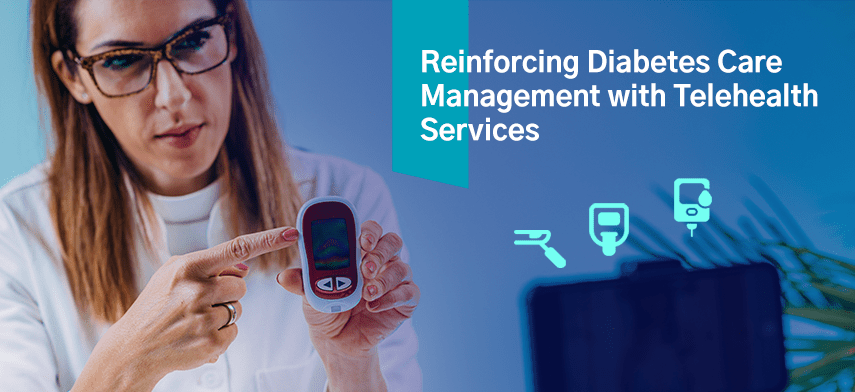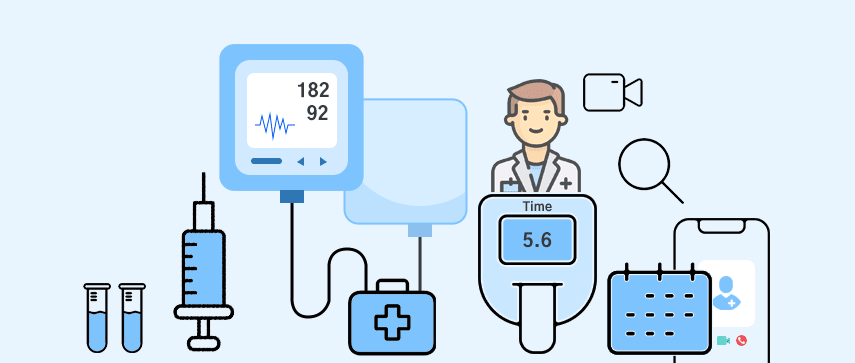Telehealth is reshaping diabetes management in the US. Almost 11% of the entire US population has diabetes, and this figure is only increasing. In addition to being a major public health crisis, diabetes is a significant financial burden. According to the CDC, diabetes is the most expensive chronic condition in the US, costing USD 327 billion every year.

In an attempt to combat these increasing costs and provide better diabetes care management, the use of telehealth has significantly increased. Telehealth can help patients save about $80 per month in diabetes management costs, while care providers can cut down 22% of their monthly expenses.
Here’s an in-depth guide to the benefits of telehealth for diabetes care management and how providers can implement a telehealth model.
Parameters of Technology and Telehealth in Healthcare
Technology has played a pivotal role in revolutionizing healthcare. It has improved the way healthcare providers operate, enabled self-care for patients, and made the healthcare space more patient-centric.
Here are some parameters of technology that have reshaped healthcare.
1 Improved access to data
The implementation of technology in healthcare has enabled the ability to store and access data in a digital form. Providers can retrieve patient data anytime and from anywhere, resulting in better quality care and patient management.
2 Better communication lines
Ineffective communication between the healthcare provider and patient has always been a hurdle of the traditional healthcare system. Health professionals can connect with patients through voice calls, text messaging, emails, video conferencing, and other modes of virtual communication.
3 Electronic health records (EHR)
Hospitals often have a hard time storing and managing patient data and records. Electronic health records (EHR) have become the norm, making it easier to store, move, and manage data across the healthcare network.
4 Telehealth/Telemedicine
Telemedicine is inarguably the most significant advantage of healthcare technology. Healthcare providers can offer their services to patients anywhere from one place. Patients can avail themselves of those services without the need for traveling to healthcare facilities.
5 Health apps
Healthcare apps bridge the gap between patients and providers. These apps allow patients to monitor their health factors, such as heart rate, blood pressure, etc., and share the data with their doctor in real-time.
Diabetes has been one of the key development areas when it comes to telehealth. According to the National Diabetes Statistics Report 2020 by CDC, 34.2 million people in the US (10.5% of the population) have diabetes, of which 7.3 million people remain undiagnosed. Furthermore, 88 million adults (34.5% of the population) aged 18 years or older have prediabetes.
The advancements in telehealth have played a significant role in controlling the diabetes situation in the US. For instance, various diabetic patients inject insulin shots and monitor their blood sugar levels themselves and share the results remotely with their physician.
Some clinically significant advantages of technology and telehealth in managing diabetes are:
Consistent monitoring
Physicians, medical professionals, and doctors can monitor their patients’ conditions around the clock through consistent virtual monitoring.
Preventative programs
Telehealth enables healthcare providers to implement preventive programs in rural and underserved areas.
Cost reductions
Patients can get quality care while spending less on diabetes management. Thus, utilizing the extra savings into other preventive care programs.
Lifestyle modifications
Physicians can assist patients with lifestyle modifications, such as weight loss, diet plans, etc., that help in better patient care management.
Better patient experience
Telehealth enables patients to achieve the best-quality medical care and management at home. This results in better engagement and experience.
Telehealth Model and the Rural Diabetes Telehealth Program
Diabetes management has improved significantly, but it’s primarily restricted to urban areas. Rural communities still don’t have access to proper diabetes care, which is a substantial public health burden. The prevalence of diabetes in nonmetropolitan counties is 12.6%, compared to 9.9% in metropolitan counties.
Implementing the telehealth model in rural communities can help support diabetes care and management. Here’s how telehealth can assist diabetes management in rural areas:
1 Diabetes self-management
Self-management is an essential aspect of diabetes care. Patients need to keep a check on their blood sugar levels, diet, and other risk factors like hypertension and obesity. With telehealth, health providers can communicate the information and guidelines essential for diabetes self-management.
2 Adherence to medical treatments
Almost two-thirds of Americans with prescriptions are non-adherent, resulting in 125,000 premature deaths each year. This is more abundant in rural areas due to a lack of constant patient monitoring. Telehealth programs would allow providers to oversee patient progress in real-time and ensure that they adhere to their treatment.
3 High-quality care
Lastly, telehealth facilitates high-quality medical care that would otherwise be unavailable in rural areas. Better medical care results in improved disease management, which ensures more favorable outcomes for patients.
Over the years, several successful rural diabetes telehealth programs have been implemented in the US. Several models for diabetes management also exist, including:
- Clinical partnership model: Various healthcare providers work together to provide diabetes management care and prevention programs.
- Self-management model: Individuals treat their condition on their own by implementing lifestyle changes.
- Community health worker model: Community health workers address individual and community-level factors associated with diabetes management.
- Faith-based model: Faith-based organizations deliver diabetes prevention and management models through churches, mosques, etc.
Health professionals can also combine the telehealth model with these diabetes monitoring systems to enable better diabetes management in rural areas.
Implementing Telehealth Diabetic Program for Best Practices

Research has proven the clinical effectiveness of telemedicine in diabetes management. Additionally, with the pandemic in hindsight, telemedicine has emerged as the preferred model for diabetes care management in both urban and rural areas.
However, implementing a full-fledged telehealth diabetic program can be challenging, especially if you’ve not worked on telehealth programs before. Here are some best practices to follow.
1 Fulfill technological requirements
The first step in implementing a telehealth diabetic program is to realize your technological requirements. To facilitate remote diabetes care management, you’ll need hardware, including smartphones, desktops, HD video cameras, etc. Next, you’ll need video conferencing software to conduct live telehealth sessions. Lastly, you’ll need a telehealth management system to seamlessly implement telehealth programs.
2 Schedule and streamline telemedicine visits
Once you have the desired technology and diabetic care solutions in place, you can start scheduling telehealth visits. However, efficient scheduling of telehealth visits isn’t enough. You’ll need to ensure that these visits are as effective as in-person visits. You can achieve that by integrating patients’ devices and health apps into the telehealth software. This helps doctors with access to the patients’ data and progress, which will help them provide better care. Alternatively, patients can upload their data, such as HbA1c values and other screening tests, before the visit.
3 Integrate data to EHR
Electronic health records (EHR) can support telehealth diabetes care management in many ways. Managing the data of multiple patients can be resource-intensive and prone to errors. EHR resolves this hurdle. It provides access to the documentation needed to support patient care. With EHR, you can also obtain accurate billing codes to track consultancy fees and other diagnostic and treatment charges.
4 Understand patient requirements to offer patient-centric care
When implementing a telehealth program, providers should maximize the benefit by understanding patient expectations and providing patient-centered care. Ensure that your programs are easy to access so that the patients can avail themselves of quality care in a hassle-free manner.
5 Manage culture change
Telehealth is a new concept not only for patients but also for providers. Therefore, it’s essential to manage cultural change and ensure that clinicians are acquainted with how diabetes telehealth networks work. It can be helpful to conduct training and demo sessions so that providers know what to expect and how to provide the best care.

Shaping the Workflow for Diabetes Care During and Post Covid-19 Pandemic
The COVID-19 pandemic has posed several challenges for diabetes care management. Healthcare providers came up with innovative service design methods to ensure seamless care management and delivery. The purpose of this approach is to deliver continuous care while enhancing the experience for patients and providers. The new diabetes monitoring system takes a systematic approach and comprises of three stages:
Pre-Consultation
In the conventional model, patients in the pre-consultation phase would receive a queue number, give the health insurance card, and wait for an appointment. In the new telehealth model, patients need to:
- Install uploader.
- Use pump and sensor.
- Upload their data.
For providers, this stage included using diabetic tool kits to prepare data analysis and layout a plan for providing optimum care.
Consultation
The consultation stage in the new model is almost similar to the conventional model. This includes:
- Discussion on general topics.
- Review uploaded patient data with patient assistance.
- Collaborative medication and prescription management.
- Scheduling next appointment.
Post-Consultation
The new model significantly optimizes the post-consultation process. In the new model, patients can just log out post-consultation without having to go through an elaborative process. The document management takes place on the telehealth software without the need for storing and maintaining paper documents. Clinical trials conducted on this new model have shown positive outcomes. Therefore, this model can improve the clinical outcomes and quality of life in people with diabetes.
Wrapping Up,
Telehealth for diabetes care management has advantages for both patients and providers. It allows care providers to continuously deliver high-quality medical care in rural areas while keeping their costs in check. On the other hand, patients can receive best-in-class care from the comfort of their homes without commuting to clinics.

Author's Bio

Shailendra Sinhasane (Shail) is the co-founder and CEO of Mobisoft Infotech. He has been focused on cloud solutions, mobile strategy, cross-platform development, IoT innovations and advising healthcare startups in building scalable products.

